The Iron Age is the final epoch of the three historical Metal Ages, after the Chalcolithic and Bronze Age. It has also been considered as the final Age of the three-age division starting with prehistory and progressing to protohistory. In this usage, it is preceded by the Stone Age and Bronze Age. These concepts originated for describing Iron Age Europe and the Ancient Near East. Still, they now include other parts of the Old World.

Gojoseon, also called Joseon, was the first kingdom on the Korean Peninsula. According to Korean mythology, the kingdom was established by the legendary king Dangun. Gojoseon possessed the most advanced culture in the Korean Peninsula at the time and was an important marker in the progression towards the more centralized states of later periods. The addition of Go, meaning "ancient", is used in historiography to distinguish the kingdom from the Joseon dynasty, founded in 1392 CE.

The Ubaid period is a prehistoric period of Mesopotamia. The name derives from Tell al-'Ubaid where the earliest large excavation of Ubaid period material was conducted initially in 1919 by Henry Hall and later by Leonard Woolley.

The Longshanculture, also sometimes referred to as the Black Pottery Culture, was a late Neolithic culture in the middle and lower Yellow River valley areas of northern China from about 3000 to 1900 BC. The first archaeological find of this culture took place at the Chengziya Archaeological Site in 1928, with the first excavations in 1930 and 1931. The culture is named after the nearby modern town of Longshan in Zhangqiu, Shandong. The culture was noted for its highly polished black pottery. The population expanded dramatically during the 3rd millennium BC, with many settlements having rammed earth walls. It decreased in most areas around 2000 BC until the central area evolved into the Bronze Age Erlitou culture. The Longshan culture has been linked to the early Sinitic . According to the area and cultural type, the Longshan culture can be divided into two types: Shandong Longshan and Henan Longshan. Among them, Shandong Longshan Cultural Site includes Chengziya Site; Henan Longshan Cultural Site includes Dengfeng Wangchenggang Site in Wangwan, Taosi Site and Mengzhuang Site in Hougang.
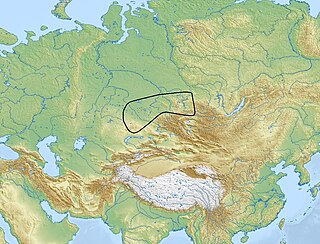
The Karasuk culture describes a group of late Bronze Age societies who ranged from the Aral Sea to the upper Yenisei in the east and south to the Altai Mountains and the Tian Shan in ca. 1500–800 BC.
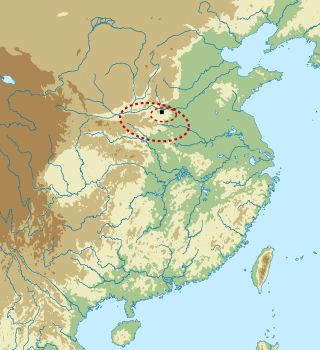
The Erlitou culture was an early Bronze Age society and archaeological culture. It existed in the Yellow River valley from approximately 1900 to 1500 BC. The culture is named after Erlitou, an archaeological site in Yanshi, Henan. It was widely spread throughout Henan and Shanxi and later appeared in Shaanxi and Hubei. Most archaeologists consider Erlitou the first state-level society in China. Chinese archaeologists generally identify the Erlitou culture as the site of the Xia dynasty, but there is no firm evidence, such as writing, to substantiate such a linkage, as the earliest evidence of Chinese writing dates to the Late Shang period.

The Majiayao culture was a group of neolithic communities who lived primarily in the upper Yellow River region in eastern Gansu, eastern Qinghai and northern Sichuan, China. The culture existed from 3300 to 2000 BC. The Majiayao culture represents the first time that the upper Yellow River region was widely occupied by agricultural communities and it is famous for its painted pottery, which is regarded as a peak of pottery manufacturing at that time.
The Afanasievo culture, or Afanasevo culture, is an early archaeological culture of south Siberia, occupying the Minusinsk Basin and the Altai Mountains during the eneolithic era, c. 3300 to 2500 BCE. It is named after a nearby mountain, Gora Afanasieva in what is now Bogradsky District, Khakassia, Russia, first excavated by archaeologist Sergei Teploukhov in 1920-1929. Afanasievo burials have been found as far as Shatar Chuluu in central Mongolia, confirming a further expansion about 1,500 km beyond the Altai Mountains. The Afanasievo culture is now considered as an integral part of the Prehistory of Western and Central Mongolia.
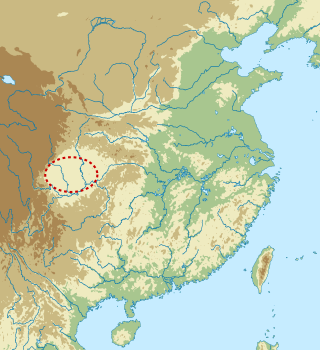
The Baodun culture was a Neolithic culture centered on the Chengdu Plain in Sichuan, China.
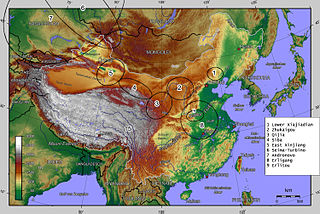
The Lower Xiajiadian culture is an archaeological culture in Northeast China, found mainly in southeastern Inner Mongolia, northern Hebei, and western Liaoning, China. Subsistence was based on millet farming supplemented with animal husbandry and hunting. Archaeological sites have yielded the remains of pigs, dogs, sheep, and cattle. The culture built permanent settlements and achieved relatively high population densities. The population levels reached by the Lower Xiajiadian culture in the Chifeng region would not be matched until the Liao Dynasty. The culture was preceded by the Hongshan culture, through the transitional Xiaoheyan culture. The type site is represented by the lower layer at Xiajiadian in Chifeng, Inner Mongolia.

The Upper Xiajiadian culture was a Bronze Age archaeological culture in Northeast China derived from the Eurasian steppe bronze tradition. It is associated with the Donghu of Chinese history.

Metallurgy in China has a long history, with the earliest metal objects in China dating back to around 3,000 BCE. The majority of early metal items found in China come from the North-Western Region. China was the earliest civilization to use the blast furnace and produce cast iron.

Prehistory, also called pre-literary history, is the period of human history between the first known use of stone tools by hominins c. 3.3 million years ago and the beginning of recorded history with the invention of writing systems. The use of symbols, marks, and images appears very early among humans, but the earliest known writing systems appeared c. 5,200 years ago. It took thousands of years for writing systems to be widely adopted, with writing having spread to almost all cultures by the 19th century. The end of prehistory therefore came at different times in different places, and the term is less often used in discussing societies where prehistory ended relatively recently.
During the late Zhou dynasty, the inhabitants of the Central Plains began to make a distinction between Hua and Yi, referred to by some historians as the Sino–barbarian dichotomy. They defined themselves as part of cultural and political region known as Huaxia, which they contrasted with the surrounding regions home to outsiders, conventionally known as the Four Barbarians. Although Yi is usually translated as "barbarian", other translations of this term in English include "foreigners", "ordinary others", "wild tribes" and "uncivilized tribes". The Hua–Yi distinction asserted Chinese superiority, but implied that outsiders could become Hua by adopting their culture and customs. The Hua–Yi distinction was not unique to China, but was also applied by various Vietnamese, Japanese, and Koreans regimes, all of whom considered themselves at one point in history to be legitimate successors to the Chinese civilization and the "Central State" in imitation of China.

The Xianyun was an ancient nomadic tribe that invaded the Zhou dynasty. This Chinese exonym is written with xian獫 or 玁 "long-snouted dog", and this "dog" radical 犭 is commonly used in graphic pejorative characters. "Xianyun" was the preferred designation for northern tribes during the Zhou dynasty, earlier designations being the Xunyu, Guifang, and later ones being the Xiongnu, during the Han dynasty.
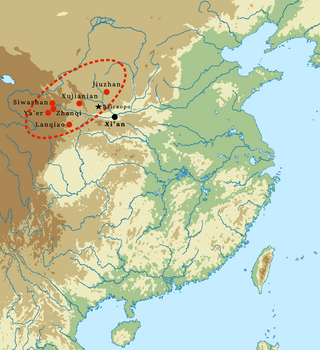
The Siwa culture was a Bronze Age culture in southeast Gansu Province, China. It was discovered by Swedish geologist Johan Gunnar Andersson in 1924 at Mount Siwa (寺洼山) in Lintao County, hence its name. It flourished circa 14th to 11th century BC, it is tentatively attributed to the cultures of the Northern Di, Qiang, and Xunyu peoples.

"Four Barbarians" was a term used by subjects of the Zhou and Han dynasties to refer to the four major people groups living outside the borders of Huaxia. Each was named for a cardinal direction: the Dongyi, Nanman, Xirong, and Beidi. Ultimately, the four barbarian groups either emigrated away from the Chinese heartland or were partly assimilated through sinicization into Chinese culture during later dynasties. After this early period, "barbarians" to the north and the west would often be designated as "Hu" (胡).
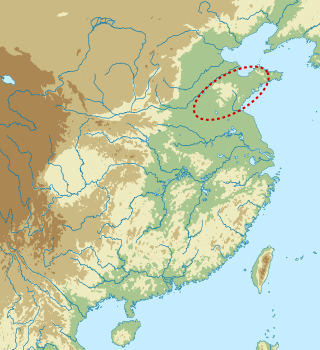
The Yueshi culture was an archaeological culture in the Shandong region of eastern China, dated from 1900 to 1500 BC. It spanned the period from the Late Neolithic to the early Bronze Age. In the Shandong area, it followed the Longshan culture period and was later replaced by the Erligang culture.

Yuri Pines is a Ukrainian-born Israeli sinologist and the Michael W. Lipson Professor of Chinese Studies at the Hebrew University in Jerusalem.
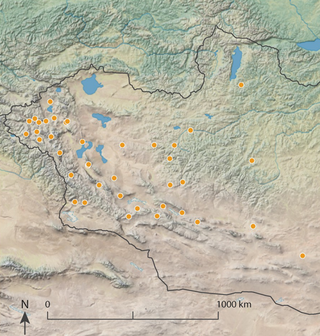
The Sagsai culture is an early Bronze Age culture of Western Mongolia. It was centered on the Sagsai area and succeeded the Chemurchek culture.

















